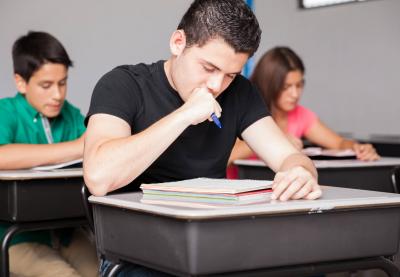We live in a new world. Here, the so-called “alt-right” has a loud voice in our nation’s politics; here, facts are countered not by lies but by “alternative facts.” The brush with which many of our most vocal leaders paint is much broader than it used to be, their views of the world and their narratives much less nuanced.
In the old world, I felt the largest percentage of my job as a high school English teacher was to develop better writers, clearer thinkers, students prepared for the academic rigors of college. In this new world, while those tasks remain at the center of my classes, I feel compelled to switch my focus. Now my primary job—and the primary job of any public school educator—is to develop better community members, more empathetic humans.
The focus of my classroom is no longer looking in—examining a writer’s strengths and weaknesses, pressing for a deeper understanding of a text. Those skills are still being taught, but only in the service of looking out. Each unit, each lesson, each class is tailored to turning students’ eyes away from the classroom and examining the world we now inhabit. Each lesson is geared toward better participation in our diverse democracy, in accordance with the United States’ most fundamental values.
This shift has demanded a great deal of rethinking and revising of my lessons. There are several core changes underway in my classes that may be worth considering in yours as well.
Use materials that confront current social issues.
In the old world, I started the year with William Carlos Williams’ The Use of Force. It is a great entryway into the careful reading, annotations and analysis I expect out of my students. It comments on power dynamics between those who are in authority and those who are not. It works well for seniors.
In this new world, I started with Toni Cade Bambara’s The Lesson. It too works well for introducing the close reading, annotations and analysis I expect. It too speaks to the distribution of power. But it also speaks directly about race, the systemic racism in the United States, the distribution of wealth, and some core principles at the heart of the Black Lives Matter movement. It allows for my students to look outward and think critically about significant social justice issues of our time.
Allow students to discuss their beliefs, not just their interpretation of a text.
After reading a story in the old world, my students would analyze elements of characterization, setting, diction. They would focus on an author’s craft and how we as readers were manipulated into drawing certain conclusions. Maybe we would get to social injustice and the intersections of poverty, affluence and education.
In the new world, I ask them to look outward and talk. First, they write for a few minutes about what they believe to be the biggest factors causing people to live in poverty. Then I give them four options: education, bad decisions, low pay, environment. They pick and go to four corners of the room, where they begin the task of trying to convince their peers to move to their corner. Here, students voice common misconceptions about how people experiencing poverty simply need to work harder, but other students counter that it is about educational opportunities and pay. We focus on how to confront misconceptions in a way that might change a mind rather than simply create an adversary.
Challenge limited perceptions.
In the old world, we were not often talking about the most controversial issues directly. We would get into them within the scope of academic questions but rarely spoke of them in the context of civic and daily life.
In the new world, that is a large percentage of our study. Now, the question is whether or not Bambara’s social criticisms are still pertinent today rather than how she generates conflict through characterization. Now, students and I challenge the limited views of their peers who have never experienced poverty and who have yet to understand their privilege.
We live in a new world. Here, teachers must teach students to raise their voices in opposition to prejudice, bias, racism and white supremacy; it can’t be optional. Here, teachers must fight alternative facts with actual facts. Here, cultivating engaged community members must be our central concern, our driving force and our guiding principle.
Knoll is a writer and English teacher at a public school in New Jersey.
